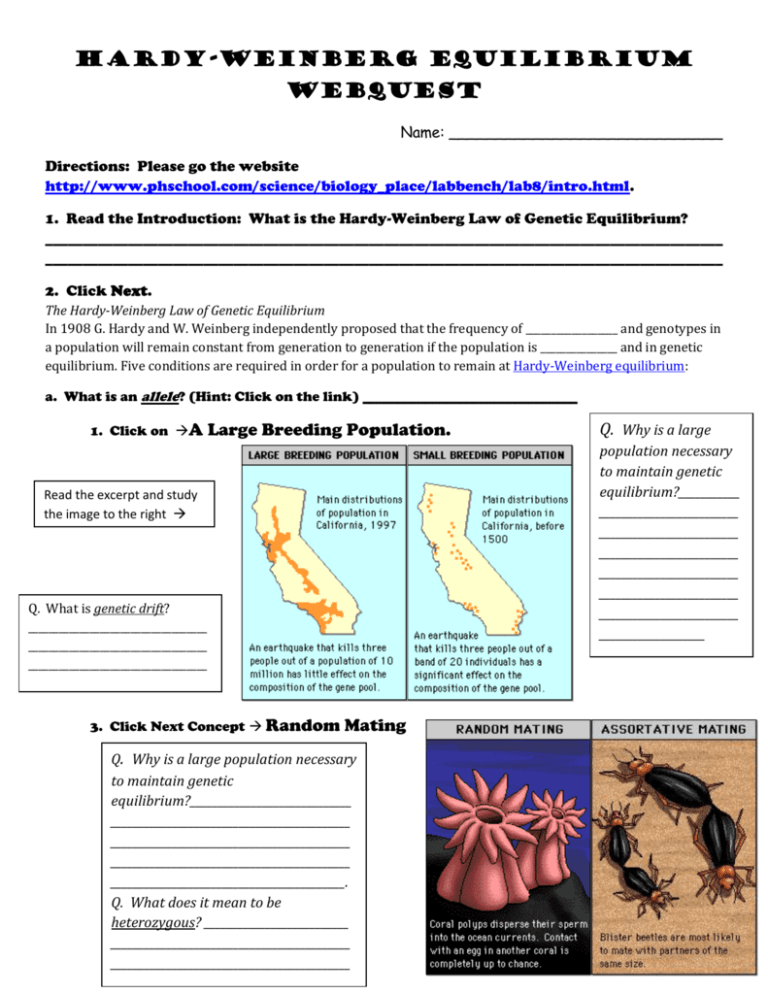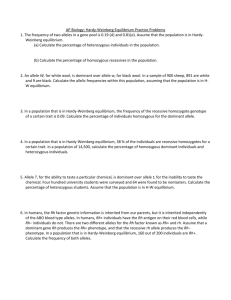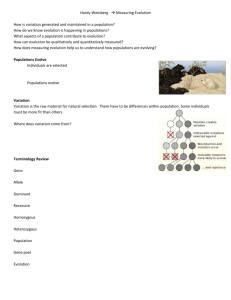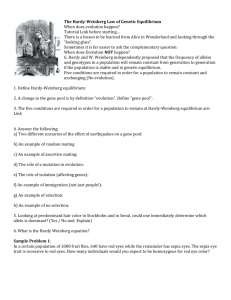Hardy Weinberg Equilibrium Lab
advertisement

Hardy-Weinberg Equilibrium Webquest Name: _____________________________ Directions: Please go the website http://www.phschool.com/science/biology_place/labbench/lab8/intro.html. 1. Read the Introduction: What is the Hardy-Weinberg Law of Genetic Equilibrium? __________________________________________________________________________________________ __________________________________________________________________________________________ 2. Click Next. The Hardy-Weinberg Law of Genetic Equilibrium In 1908 G. Hardy and W. Weinberg independently proposed that the frequency of __________________ and genotypes in a population will remain constant from generation to generation if the population is _______________ and in genetic equilibrium. Five conditions are required in order for a population to remain at Hardy-Weinberg equilibrium: a. What is an allele? (Hint: Click on the link) _______________________________ 1. Click on A Large Breeding Population. population necessary to maintain genetic equilibrium?___________ _________________________ _________________________ _________________________ _________________________ _________________________ _________________________ ___________________ Read the excerpt and study the image to the right Q. What is genetic drift? ___________________________________ ___________________________________ ___________________________________ 3. Click Next Concept Random Q. Why is a large Mating Q. Why is a large population necessary to maintain genetic equilibrium?_____________________________ ___________________________________________ ___________________________________________ ___________________________________________ __________________________________________. Q. What does it mean to be heterozygous? __________________________ ___________________________________________ ___________________________________________ 4. Click Next Concept NO MUTATIONS Q. What would happen if to the gene pool if a mutation occurs? ____________________________________________ ____________________________________________ ____________________________________________ 5. Click Next Concept No Immigration or Emigration Q. What is migrating into this population of trees that can alter the gene pool? ____________________________________________ 6. Click Next Concept No Natural Selection Click Spray! Q. Which type of weeds will pass on their genes after being sprayed with herbicide? ____________________________________ 7. Click Next Concept. Piggies! Q. How many recessive alleles do you count? ________ 8. Check your answers. Q. Why can’t you count the number of recessive alleles just by looking at the phenotypes of the piggies? ___________________________________________________________________________________________________________________ ________________________________________________________________________________________ 9. Click Next Concept. This page is copied below so you can refer back to it. To estimate the frequency of alleles in a population, we can use the Hardy-Weinberg equation. According to this equation: p = the frequency of the dominant allele (represented here by A) q = the frequency of the recessive allele (represented here by a) For a population in genetic equilibrium: p + q = 1.0 (The sum of the frequencies of both alleles is 100%.) (p + q)2 = 1 so p2 + 2pq + q2 = 1 The three terms of this binomial expansion indicate the frequencies of the three genotypes: p2 = frequency of AA (homozygous dominant) 2pq = frequency of Aa (heterozygous) q2 = frequency of aa (homozygous recessive) 10. Click Next Concept. Calculations: Record your answers in the space provided. You can check your answers at any time. 1. Calculate q2. (Hint: Count up the number of black piggies and divide by the total number of piggies). _______________ 2. Find q. _________ 3. Find p. __________ 4. Find 2pq. ________ 11. Click Next Concept. Try Sample Problem 2. How many flies have red eyes? __________ How many flies have sepia eyes? _________ Which trait is dominant? _______________ a. Find q2. (percent of recessive organisms) _____ b. Find q. (take square root of this number) _____ c. Find p. (Using the equation p+q =1) ______ d. How many can you expect to be homozygous dominant? _________________ (Hint: p2) 12. Click Next Concept. Sample Problem 3: PKU in humans. (Causes mental retardation). The Hardy-Weinberg equation is useful for predicting the percent of a human population that may be heterozygous carriers of recessive alleles for certain genetic diseases. Phenylketonuria (PKU) is a recessive human metabolic disorder that results in mental retardation if it is untreated in infancy. In the United States, one out of approximately 10,000 babies is born with the disorder. Approximately what percent of the population are heterozygous carriers of the recessive PKU allele? Find q2. ________ Find q. ________ Find p. ________ Heterozygous carriers? _____________ (Hint: Use 2pq) 13. Click Next Concept Allelic Frequency vs. Genotypic Frequency If you are told that the frequency of a recessive allele in a population is 10%, you are directly given q, since by definition q is the frequency of the recessive allele. This comprises all the copies of the recessive allele that are present in heterozygotes as well as all the copies of the allele in individuals that show the recessive phenotype. Q. What is q for this population?____________ Sample Problem If you observe a population and find that 16% show the recessive trait, you know the frequency of the aa genotype. This means you know q2. Q. What is q for this population? _____________ Give yourself a pat on the back! You just survived the Hardy-Weinberg Madness!! Now, hand it in and I’ll give you some points for your fabulous work.









